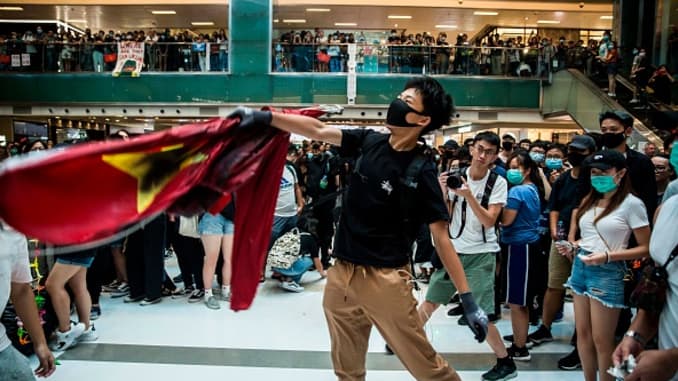AP

Pro-democracy protesters desecrate the Chinese national flag during a protest at the New Town Plaza shopping mall in Hong Kong’s Sha Tin district on September 22, 2019.
Protesters in Hong Kong trampled a Chinese flag, vandalized a subway station and set a fire across a wide street on Sunday.
The day’s action began peacefully, as protesters filled a shopping mall and, in a new twist, folded paper “origami” cranes that they tied onto a large rigging that they assembled in the mall in the Shatin district.
Some put a Chinese flag on the floor and took turns running over it, before defacing it and putting it in a dumpster outside, which they then pushed into a nearby river.
One group later attacked the Shatin subway station, which is connected to the mall.
They jumped up to smash overhead surveillance cameras, used hammers to knock ticket sensors off gates and spray-painted and broke the screens of ticket machines, using umbrellas to shield their identities.
Riot police arrived following the attack and guarded the station after it was closed, with a metal grill pulled down to block entry.
Protesters then built a barricade across a street near the mall, piled what appeared to be brown palm fronds on top and set them on fire.
Police fired tear gas as they tried to advance on the protesters, who had retreated before taking a position behind a wall of umbrellas that those in the front held.
Riot police arrived following the attack and guarded the station after it was closed, with a metal grill pulled down to block entry.
Protesters then built a barricade across a street near the mall, piled what appeared to be brown palm fronds on top and set them on fire.
Police fired tear gas as they tried to advance on the protesters, who had retreated before taking a position behind a wall of umbrellas that those in the front held.
Protesters says the extreme actions are needed to get the government’s attention.
On Saturday night, police used tear gas and rubber rounds against protesters who threw gasoline bombs toward them and set fires in streets.
Before making the origami cranes, protesters at the Shatin New Town Plaza mall chanted slogans and sang a song that has become their anthem, backed by a small group playing on woodwind and brass instruments through their masks.
Before making the origami cranes, protesters at the Shatin New Town Plaza mall chanted slogans and sang a song that has become their anthem, backed by a small group playing on woodwind and brass instruments through their masks.
Many lined the balustrades of the three higher floors overlooking where others gathered in the wide space below.
Hong Kong’s leader, Chief Executive Carrie Lam, has agreed to withdraw an extradition bill that sparked the protests in June.
Hong Kong’s leader, Chief Executive Carrie Lam, has agreed to withdraw an extradition bill that sparked the protests in June.
But the anti-government protesters are pressing other demands, including fully democratic elections in the semiautonomous Chinese territory and an independent investigation of police violence during earlier demonstrations.
Protesters say Beijing and Lam’s government are eroding the “high degree of autonomy” and Western-style civil liberties promised to the former British colony when it was returned to China in 1997.
The unending protests are an embarrassment for China’s Communist Party ahead of Oct. 1 celebrations of its 70th anniversary in power.
Protesters say Beijing and Lam’s government are eroding the “high degree of autonomy” and Western-style civil liberties promised to the former British colony when it was returned to China in 1997.
The unending protests are an embarrassment for China’s Communist Party ahead of Oct. 1 celebrations of its 70th anniversary in power.
Hong Kong’s government has canceled a fireworks display that day, citing concern for public safety.
Transit authorities closed two stations on the airport express train to guard against a possible disruption of transportation to the transportation hub, but none had materialized by late Sunday afternoon.
The Hong Kong International Airport Authority said the train would operate between the airport and the terminus station in the center of the city, without making its usual stops in between.
Transit authorities closed two stations on the airport express train to guard against a possible disruption of transportation to the transportation hub, but none had materialized by late Sunday afternoon.
The Hong Kong International Airport Authority said the train would operate between the airport and the terminus station in the center of the city, without making its usual stops in between.
Some airport bus routes were also suspended.
Passengers were advised to leave sufficient time to reach the airport.
Passengers boarding the train were told via onboard announcements that it would make fewer stops than usual, with no mention of the protests.
Passengers boarding the train were told via onboard announcements that it would make fewer stops than usual, with no mention of the protests.
Orange tape blocked the turnstiles at the empty Kowloon station, and police clutching riot helmets greeted arriving passengers at the Hong Kong terminus.
